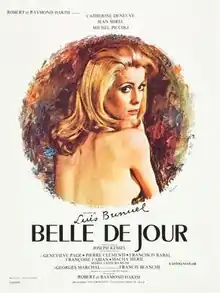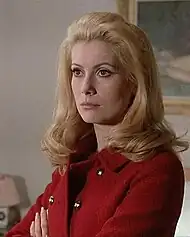| Belle de Jour | |
|---|---|
 Theatrical release poster | |
| Directed by | Luis Buñuel |
| Screenplay by |
|
| Based on | Belle de Jour by Joseph Kessel |
| Produced by |
|
| Starring | |
| Cinematography | Sacha Vierny |
| Edited by | Louisette Hautecoeur |
Production companies |
|
| Distributed by |
|
Release dates |
|
Running time | 101 minutes |
| Countries | |
| Languages |
|
| Box office | 2,162,160 admissions (France)[2] |
Belle de Jour (pronounced [bɛl də ʒuʁ]) is a 1967 psychological drama film directed by Luis Buñuel, and starring Catherine Deneuve, Jean Sorel, and Michel Piccoli. Based on the 1928 novel Belle de Jour by Joseph Kessel, the film is about a young woman who spends her midweek afternoons as a high-class prostitute, while her husband is at work.[3]
The title of the film is a play on words on the French term belle de nuit ("beauty of the night", i.e., a prostitute), as Séverine works during the day under the pseudonym "Belle de Jour". Her nickname can also be interpreted as a reference to the French name of the morning glory (Convolvulaceae), meaning "beauty of [the] day", a flower that blooms only during the day.
Belle de Jour is one of Buñuel's most successful and famous films. It was Deneuve's second acclaimed success after The Umbrellas of Cherbourg.[4] It won the Golden Lion and the Pasinetti Award for Best Film at the Venice Film Festival in 1967.[5]
Plot
Séverine Serizy (Catherine Deneuve), a young and beautiful housewife, is unable to share physical intimacy with her husband, Dr. Pierre Serizy (Jean Sorel), despite their love for each other. Her sexual life is restricted to elaborate fantasies involving domination, sadomasochism, and bondage. Although frustrated by his wife's frigidity toward him, he respects her wishes.
While visiting a ski resort, they meet two friends, Henri Husson (Michel Piccoli) and Renée (Macha Méril). Séverine does not like Husson's manner and the way he looks at her. Back in Paris, Séverine meets up with Renée and learns that a common friend, Henriette, now works at a brothel. At her home, Séverine receives roses from Husson and is unsettled by the gesture. At the tennis courts, she meets Husson and they discuss Henriette and houses of pleasure. Husson mentions a high-class brothel to Séverine at 11 Cité Jean de Saumur. He also confesses his desire for her, but Séverine rejects his advances.

Haunted by childhood memories, including one involving a man who appears to touch her inappropriately, Séverine goes to the high-class brothel, which is run by Madame Anaïs (Geneviève Page), who names her "Belle de Jour." That afternoon Séverine services her first client. Reluctant at first, she responds to the "firm hand" of Madame Anaïs and has sex with the stranger. After staying away for a week, Séverine returns to the brothel and begins working from two to five o'clock each day, returning to her unsuspecting husband in the evenings. One day, Husson comes to visit her at home, but Séverine refuses to see him. Still, she fantasizes about having sex with him in her husband's presence. At the same time, Séverine's physical relationship with her husband is improving and she begins having sex with him.
Séverine becomes involved with a young criminal, Marcel (Pierre Clémenti), who offers her the kind of thrills and excitement of her fantasies. One day, Husson visits the brothel and discovers Séverine, who asks him not to tell her husband about her secret life. He agrees and rejects her services, stating he is no longer attracted to her. Séverine decides to leave the brothel, with Madame Anaïs' blessing as she believes it is due to Marcel becoming increasingly jealous and demanding. After one of his associates follows Séverine to her home, Marcel visits her and threatens to reveal her secret to her husband. Séverine pleads with him to leave, which he does, referring to her husband as "the obstacle".
Marcel waits downstairs for Pierre to return home and shoots him three times. Marcel then flees but is shot dead by police. Séverine's husband survives but is left in a coma. The police are unable to find a motive for the attempted murder. Sometime later Séverine is at home taking care of Pierre, who is now paralysed, blind and in a wheelchair. Husson visits Pierre to tell him the truth about his wife's secret life; she does not try to stop him. After Husson leaves, Séverine returns to see Pierre crying. In an ambiguous ending which is hinted to be another of her fantasies, Pierre then gets out of the wheelchair, pours himself a drink and discusses holiday plans with Séverine.
Cast

- Catherine Deneuve as Séverine Serizy, alias Belle de Jour
- Jean Sorel as Pierre Serizy
- Michel Piccoli as Henri Husson
- Geneviève Page as Madame Anaïs
- Pierre Clémenti as Marcel
- Françoise Fabian as Charlotte
- Macha Méril as Renée
- Maria Latour as Mathilde
- Marguerite Muni as Pallas
- Francis Blanche as Monsieur Adolphe
- François Maistre as The professor
- Georges Marchal as Duke
- Francisco Rabal as Hyppolite
Production
- Costume design
Much of Deneuve's wardrobe was designed by Yves St. Laurent.
- Filming locations
- 1 Plâce Albin-Cachot, Paris 13, France
- 79 Champs-Élysées, Paris 8, France
- Chalet de la Grande Cascade, Bois de Boulogne, Paris 16, France
- Champs Elysées, Paris 8, France
- Rue de Messine, Paris 8, France (Serizy's home)[6]
Release
Critical response
On the review aggregator website Rotten Tomatoes, Belle de Jour holds an approval rating of 95% based on 60 reviews, with an average rating of 8.6/10. The website's critics consensus reads, "The radiantly filmed Belle de Jour entrances even as it resists easy interpretations."[7] Roger Ebert of RogerEbert.com gave the film 4 stars out of 4 and included it into his Great Movies list.[8]
Awards and nominations
| Year | Award | Recipient | Result |
|---|---|---|---|
| 1967 | Venice Film Festival Golden Lion Award | Luis Buñuel | Won |
| 1967 | Venice Film Festival Pasinetti Award for Best Film | Luis Buñuel | Won |
| 1968 | Bodil Award for Best European Film | Luis Buñuel | Won |
| 1968 | French Syndicate of Cinema Critics Award for Best Film | Luis Buñuel | Won |
| 1969 | BAFTA Award Nomination for Best Actress | Catherine Deneuve | Nominated |
Home media
American director Martin Scorsese promoted a 1995 limited re-release in America[9] and a 2002 release on DVD.
Legacy
In 2006, Portuguese director Manoel de Oliveira released Belle Toujours, imagining a future encounter between the characters of Séverine and Henri Husson from the original film.[10]
In 2010, Belle de Jour was ranked No. 56 in Empire magazine's list of the 100 Best Films of World Cinema.[11]
See also
References
- 1 2 "Belle de Jour (1966) – Luis Buñuel". AllMovie. Retrieved 12 March 2021.
- ↑ "Belle de jour (1967)". JP Box-Office (in French). Retrieved 12 March 2021.
- ↑ "Belle de Jour". Internet Movie Database. Retrieved 12 March 2021.
- ↑ "Catherine Deneuve, ses films cultes". ELLE. Retrieved 7 April 2023.
- ↑ "Awards for Belle de Jour". Internet Movie Database. Retrieved 29 April 2012.
- ↑ "Locations for Belle de Jour". Internet Movie Database. Retrieved 12 March 2021.
- ↑ "Belle du Jour". Rotten Tomatoes. Retrieved 14 August 2023.
- ↑ Ebert, Roger (25 July 1999). "Belle de Jour". RogerEbert.com. Retrieved 12 March 2021.
- ↑ per DVD extras trailer
- ↑ French, Phillip (23 November 2008). "Belle toujours". The Observer. Retrieved 12 March 2021.
- ↑ "The 100 Best Films of World Cinema". Empire. Retrieved 12 March 2021.
External links
- Belle de Jour at IMDb
- Belle de Jour at AllMovie
- Belle de jour: Tough Love – an essay by Melissa Anderson at The Criterion Collection